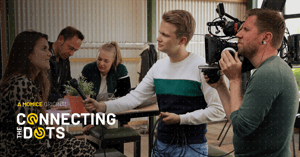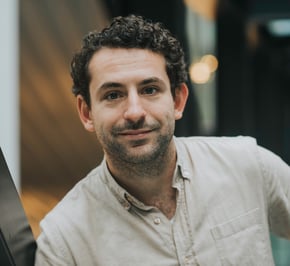On May 14, the second edition of Connecting the Dots took place. This Momice and Sendsteps event focused on increasing the impact of events. At the event, Rutger Bremer (founder Momice) and Gert Slob (behavioural scientist at the Behavior change group) presented the Event Blueprint – a tool that helps event professionals formulate proper event targets in order to measure their results.
Daphne Engelbert (event organiser at the City of Rotterdam), Vere Hullegie (event coordinator at BOVAG) and Jelko de Ruijter (Spokesman of the HKU [University of the Arts Utrecht]) share their event experiences. Hullegie: “Many events are either very abstract or offer no new information. In that aspect, Connecting the Dots is very distinguishing.”
Curious about the most important lessons of the event? You can read them here!
Never stop asking 'why?'
In the City of Rotterdam event team, Daphne Engelbert often takes on the role of criticaster. For Engelbert, Connecting the Dots hits home. “This event confirms my motivation to always keep asking questions. I always say the first phase of the event involves the majority of the work. Especially the conversation with the (internal) client is challenging and time consuming. In this phase, don’t go off half-heartedly but be discerning and stay curious about the underlying reason to organise an event. Ask ‘why’ a thousand times if necessary, always keep wondering why a specific event is organised. Give your (internal) client something to think about, and stay away from production mode for a while.”
Engelbert found it useful to discover the three ways of resistance to behavioural change, that were discussed in the event. “Being part of a governmental institution, you have to be extra aware of that. The new perspectives and information are interesting and applicable. How I would summarise the event? Event professionals: Without a core message, you’ll only talk gibberish!”
Useful non industry-related insights
Vere Hullegie, event coordinator at BOVAG also attended the first edition of Connecting the Dots. Even though she didn’t quite know what to expect from this edition, she is very pleased she came. “It’s so cool that a real Event Blueprint* has been presented. It gives you concrete tools to deepen your knowledge and have a closer look at your role as event professional. It is clear we should use the Event Blueprint, although it will take some more time to really get the hang of it. That time investment is definitely one I am willing to make.”
*For now, the Event Blueprint is only available in Dutch. English version coming soon!
According to Hullegie, a speaker from outside of the industry was a welcome change. “On the other hand, it is nice to solve an event case together with colleagues from the industry. By doing this, we learned how to apply the theory.” The event coordinator values the event with an 8. “I’m pleasantly surprised. Many events are either very abstract or offer little concrete or new information. You only visit an event during office hours if it offers real added value, which was the case at this event. The promise made at the start of Connecting the Dots – preparing event professionals for the future – seems to be fulfilled. I would recommend other event professionals to attend the next editions of Connecting the Dots.”
Communication professional will also thrive at Connecting the Dots
Jelko de Ruijter works as spokesman at the communication department of the HK and visited Connecting the Dots together with his colleague Dennis Voortman. He thinks it is eye-opening to see that the challenges of event and communication professionals are very similar. “To be able to do your work, you often rely on the assignment provided by your supervisor. Therefore it is very important that the ‘why’ question is properly answered. Why are we doing what we’re doing and what is the main goal? Not only is it satisfactory for your own job, it also improves the results considerably.”
De Ruijter: “In the communication field, we often talk about storytelling: telling the story of your organisation through illustrative examples through the means that work best for you. Storytelling will only work well when you know the essence of your organisation. What is it exactly we are doing, what do we stand for and what is our mission? This knowledge is used to build a communication strategy. Which stories do we tell with on which channels and for which target audience? I can imagine that it works the same way for event managers. In fact: you can complement each other in this. An event is just as an important channel to tell the story of your organisation’s. I therefore think it would be wise for communication specialists to join their event managers in visiting Connecting the Dots.”
Conclusion
The second edition of Connecting the Dots gives event professionals concrete tools to take on a more strategic role. The Event Blueprint really hits home for those who already are adapted to a more discerning and questioning role. The challenges of event and communication professionals prove to be very similar. Visiting a Connecting the Dots event, together with a marketing or communication colleague, is therefore recommended.
Connecting the Dots
Because Connecting the Dots is a Dutch-language event, it is less suitable for English speaking attendees. However, we feel the articles we write about this topic could be of added value for all event professionals. Are you interested in the content? Read more here!

